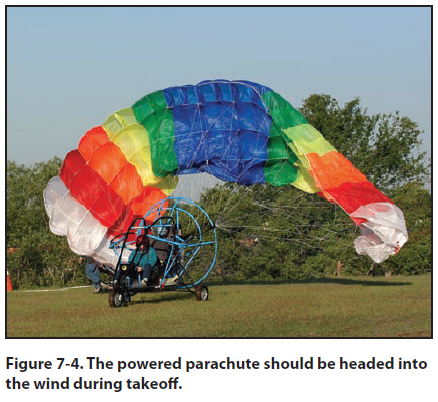|
Chapter 7 — Takeoffs and Departure Climbs
Normal Takeoff
A normal takeoff is one in which the powered parachute
is headed into the wind and the wind is light
to moderate. [Figure 7-4] The takeoff surface should
be firm, free of debris, and not have any obstructions
along the takeoff path. The takeoff surface should
have sufficient length to permit the powered parachute
to quickly accelerate to normal flight speed.

There are three reasons for making a takeoff as directly
into the wind as possible:
1. A slower ground speed reduces wear and stress
on the landing gear;
2. The headwind helps inflate the wing and get it
overhead more quickly;
3. A shorter ground roll, and therefore less runway
length, is required to lift off.
Takeoff Roll
Once there is a commitment to take off, it takes a
minimum airspeed to keep the wing inflated. Inflating
the chute, then cutting the power, will usually result in
the wing deflating and falling to the ground. This can
be difficult to recover from and should only be done
if you wish to abort the takeoff.
Otherwise, as the speed of the takeoff roll increases,
more and more pressure will be felt on the steering
control tubes. It is important during this time to keep
the wing going in the same direction as the cart. This
means using the ground controls and/or the flight controls
to keep the cart and the wing coordinated.
After kiting the wing and performing the LOC preflight
check as discussed in Chapter 5, takeoff power
is applied and you accelerate to flying speed.
Rotation
When the wing has enough lift to rotate the cart nose
off of the ground, nosewheel steering becomes ineffective.
This means that even though the back wheels
of the machine are still on the ground, the cart will be
steered by the wing. You should not attempt any kind
of tight radius turn during this process.
Lift-Off
Once the wing is overhead and enough power is added,
the powered parachute will lift off the ground.
Initial Climb
Once the cart is off the ground, it is important to maintain
at least the same throttle setting that got it off the
ground in the first place. When the cart is free from
ground friction on the landing gear, it will begin to
climb.
Once the powered parachute is off the ground, prop
torque may become noticeable. It will typically steer
the aircraft to the left (with a clockwise spinning propeller).
Wind can also affect the direction of the PPC
after liftoff. During initial climb, it is important that
the initial climb path remain aligned with the runway
to avoid drifting into obstructions, or the path of another
aircraft that may be taking off from a parallel
runway. Proper scanning techniques are essential to
a safe takeoff and climb, not only for maintaining attitude
and direction, but also for collision avoidance
in the airport area.
The powered parachute’s takeoff performance will be
much different when there is less weight with only
one person in the PPC. Due to decreased load, the
powered parachute will become airborne sooner,
climb more rapidly, climb at a much steeper angle,
and the flight controls may seem more sensitive.
Common errors in the performance of normal takeoffs
and departure climbs are:
• Failure to adequately clear the area prior to
taxiing into the staging position.
• Poor selection of a staging position. (Not
allowing for enough takeoff area.)
• Failure to set up the powered parachute into the
wind.
• Abrupt use of the throttle resulting in additional
stress on the wing during inflation.
• Not using enough power to kite the wing.
• Failure to observe the wing during inflation.
• Failure to perform the rolling LOC preflight to
clear the wing.
• Abrupt use of the throttle resulting in the
aircraft porpoising.
• Failure to anticipate the left turning tendency
(as discussed in Chapter 2) on initial
acceleration.
• Overcorrecting for left turning tendency.
|

